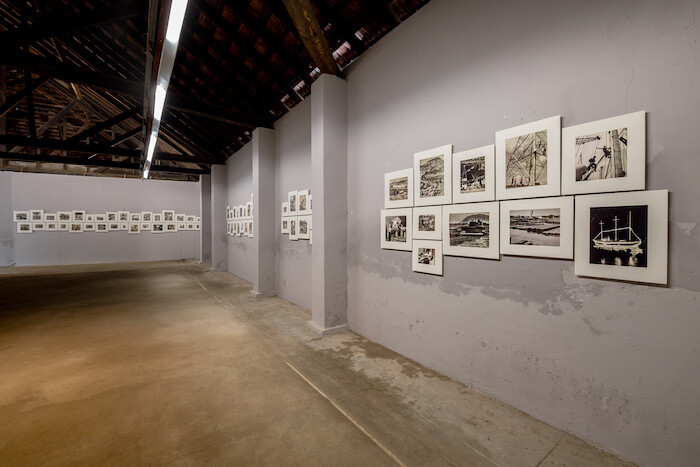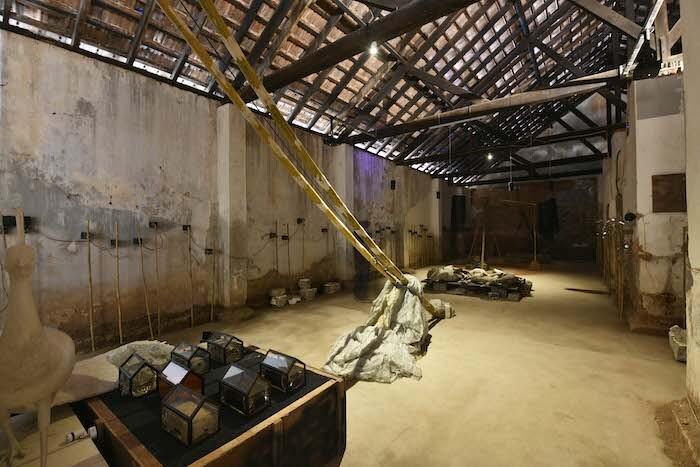In August 2018, four months before the fourth Kochi-Muziris Biennale opened, Kerala was hit by a catastrophic monsoon. It resulted in the worst flooding in the region for over a century: more than 300 people died and an estimated 220,000 were left homeless. The devastation of the floods brings the biennale’s idealistic curatorial vision—to develop “the warm solidarities of community” and a “politics of friendship,” in the words of its curator Anita Dube—into sharp relief.1 So do allegations of sexual harassment by prominent figures in India’s art world, including one of the biennale’s co-founders, artist Riyas Komu, who stepped down as the biennale’s secretary in October. Visitors may wonder how the biennale can achieve its ambition to engage with local audiences, while at the same time confronting institutional sexism, addressing its international publics, and responding to natural disaster.
A number of the exhibited artworks engage with the ecocatastrophe directly. Prominent among them is Marzia Farhana’s installation Ecocide and the Rise of Free Fall (2018). Suspended on wires in several rooms in Aspinwall House, the biennale’s main venue, are objects salvaged from flooded areas in Kerala: refrigerators, ceiling fans, vending and washing machines, books, and so on. At the Pepper House, Veda Thozhur Kolleri’s installation Rigor Mortis (2018) includes assemblages of weather-worn materials salvaged from the wetlands, while in Jun Nguyen-Hatsushiba’s dreamlike video installation Memorial Project Nha Trang, Vietnam: Towards the Complex – For the Courageous, the Curious, and the Cowards (2001), Vietnamese fishermen pedal a rickshaw across the sea floor, their progress interrupted by the periodic need to come up for air. It is a truly immersive work: the video is screened in a flooded room in which viewers can wade shin-deep in water. Mónica Mayer’s participatory installation The Clothesline Project (1978–ongoing), meanwhile, asks visitors: “What did the flood take away from you? What did the flood give you?” Hundreds of notecards are pegged to clotheslines in a tight grid of responses. One answer reads: “It taught me how meaningless our fights in the name of religion are.”
On the opening day, I walked past the dilapidated Arts and Sports Club of the Calvathy Comrades. A middle-aged man was sitting on the bench outside reading a Malayali newspaper. On the faded exterior of the building behind him were murals of Che Guevara and Fidel Castro. The scene was a reminder. While the exhibition has become known as the “People’s Biennale,” its unofficial nickname also invokes Kerala’s history as one of the earliest states in the world to democratically elect a communist government.
During the 1980s, Dube was part of the Indian Radical Painters and Sculptors Association, whose members saw art through a Marxist lens, as a means of engaging with and supporting the working classes. “Possibilities for a Non-Alienated Life,” with its stated maxim to “reject an existence in the service of capital,” suggests the ongoing influence of this school of thought on Dube’s curatorial priorities.2 Fitting with the biennale’s emphasis on the lives of marginalized peoples are the late Sunil Janah’s photographs of everyday agrarian life in India, taken in the 1940s and ’50s. Janah’s photographs chronicle the lives of the peasantry during exceptional moments in Indian history: its partitioning, its first decade as a republic, and the history of the Communist Party of India. B V Suresh’s multimedia installation Canes of Wrath (2018) foregrounds an altogether different political climate. Walking canes strike the ground as if in protest. A projection of the scowling “angry Hanuman”—a viral cartoon that has become an emblem of hypermasculine Hindutva majoritarianism—overlooks the space. A spotlight darts across the wall. A broom, dragged around by an overhead machine, performs sweeping circumambulations. It’s a symbol for historically marginalized communities that nods to the Swachh Bharat Abhiyan initiative, Narendra Modi’s high-profile drive to create a “clean India.” Suresh’s theatrical installation captures the political and social malaise of the country’s present—its religious fundamentalism, authoritarian rule, and communal violence—for which the biennale as a whole seeks cures.
The nature of these cures is suggested by the biennale’s title, “Possibilities for a Non-Alienated Life.” It calls to mind Indian philosopher Akeel Bilgrami’s concept of the “unalienated life,” which draws on Karl Marx and Mohandas Karamchand Gandhi to emphasize the importance of community, solidarity, and belonging. Crucially, however, Dube has opted for a prefix that brings to mind the Non-Aligned Movement, a group of decolonizing nations co-founded in 1961 by Jawaharlal Nehru in opposition to imperialism, neo-colonialism, and racism. The biennale thus positions itself as a discursive space in which marginalized voices—older women, queer communities, indigenous people—can be heard.
Brook Andrew’s installation The Space Between (2018) seeks affinities between different indigenous peoples in the colonized worlds. Large textiles and inflatable orbs hang from the roof of TKM Warehouse, the latter appearing to inhale and exhale like living creatures. Patterned in striking monochrome, these inflated forms borrow motifs from the decorated shields of Andrew’s Wiradjuri ancestors in contemporary Australia. On the accompanying fabrics, hand-woven in Kerala, are images derived from imperial collections such as the State Library of Victoria—silkscreen portraits of Australia’s indigenous peoples, historical images of the colonial administration, and a malnourished Indian man. By restaging archival imagery and combining image and text from Kerala and Australia, Andrew’s installation offers a counterpoint to dominant colonial narratives, connecting disparate histories of oppressed peoples from two erstwhile corners of the British Empire.
Not all crisscrossing of class, color, and creed are as convincing. On day two of the opening, artist and theorist Bracha L. Ettinger’s keynote lecture struck a discordant note. This was less the result of Ettinger’s repertoire of neologisms—“self-fragulation,” “matrixial trans-subjectivity”—than the tone of her address. Ettinger said, for example, that she hoped the keynote wasn’t too difficult to understand, asking audiences to meet with her individually so she could explain the terms. In the context of the biennale, Ettinger’s patronizing mode of address was positively alienating.
Designed by Anagram Architects in the yard of Aspinwall House is the Biennale Pavilion, a space intended for discussion and discontent, conversation and curation. The day after Ettinger’s keynote, the Pavilion hosted a performance-lecture by the Guerrilla Girls, whose Q&A session was interrupted by a group of artists, curators, writers, and others who read a jointly authored statement in response to the biennale administration’s silence about the allegations of sexual misconduct by Komu. Although he stepped down after the allegations surfaced on an Instagram account called Scene and Herd—an anonymous collective that aims to “[cut through] BS in the Indian Art world, one predator and power play at a time”3—the protesters felt the complaint was not being appropriately investigated by the biennale. There was perhaps no more appropriate and powerful moment to stage the intervention than during a performance-lecture about fighting sexism in the arts. The “insurrection,” as Dube later termed it, was one example of how the Pavilion—and by extension the biennale—can begin to deliver on its promise to offer alternatives to alienated lives.
Anita Dube, “Possibilities for a Non-Alienated Life,” http://www.kochimuzirisbiennale.org/2018-concept/.
Ibid.
https://www.instagram.com/herdsceneand.











